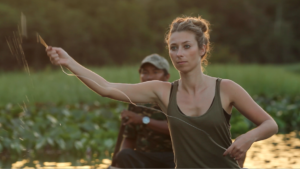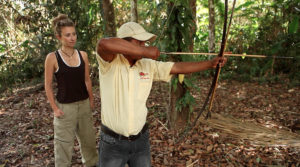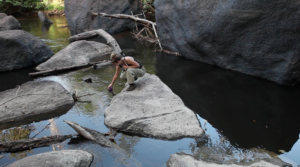By Julia Dimon
With jaguars, anacondas, black caiman and piranha, the jungle is home to a long list of creatures eager to eat, squeeze, bite or nibble on you if given the chance. With so many predator-free high-end luxury resorts around the world, it’s a wonder why people would choose to spend their vacation time in the thick of nature, (far from air-conditioning, room service or cable) battling the elements. Seems counter-intuitive, but learning to survive in the jungle is the exact reason why I, like the many other adventure-seekers before me, have found themselves in Guyana.
Nestled between Brazil and Venezuela, approximately 80 percent of this small South American country is primary tropical rainforest, making it the perfect locale for Bear Grylls wannabes on a quest to survive.

Deep in the Amazonian Basin, a few hours walk from the tiny Amerindian village of Surama, I followed a trio of Makushi guides into the jungle for a two-day survival adventure. This remote jungle experience teaches guests how to hunt using a traditional bow and arrow, set traps for small animals, hand fish, sleep in jungle hammocks and make fire.
Part of an itinerary planned by Adventure Life (a tour operator offering multi-sport and adventure expeditions across Central and South America), this jungle survival course is an exercise in self-preservation and indigenous skills.
So there we were, in the middle of the jungle, trying to find a good place to camp. My guide signaled to a grassy patch of land that seemed suitable for a makeshift home. He handed me a machete and instructed me to clear away the vines that carpeted the jungle floor (so you can spot creepy crawlies who try to cuddle with you in the middle of the night). With the area clear, I strung my hammock between two trees, adjusted a tarp overtop, secured a mosquito net and voila. It was no [fancy hotel], but did serve as an effective shelter.

With camp set up, next task was to hunt for our dinner using a traditional bow and arrow. I’ve seen the movie “Hunger Games”, I know how it’s done. Turns out that real life archery requires a combination of strength, co-ordination and timing… a trifecta I pretty much sucked at. From hunting, we tried fishing for our dinner. Using plump white grubs as bait, we caught a few small piranhas, skewered the boney fish and grilled them over an open flame.
Post dinner, I retreated to my hammock to begin my going-to-bed ritual. As I reached for a toothbrush in my backpack, which was slung over a nearby tree branch, I saw something move. It was a massive wolf spider, double the size of my hand, crawling slowly up and territorially over my bag. I recoiled. I’m not a fan of spiders, certainly not big hairy ones laying claim to my belongings. My guide grabbed a stick and poked him until he scurried away. Then one of his wolf spiders buddies emerged from my bag. There were spiders everywhere! I’d set up camp smack in the middle of a wolf spider compound. Just great.
Unsettled, but unscathed, I slipped beneath my mosquito net and obsessively checked the innards of my hammock. No spiders there thank goodness!
Just as I was attempting to relax and settle in for the night, I spotted something big and black move inside my net. Bullet ant! Though they’re only an inch long, bullet ants are nasty little guys with reputations as the world’s most painful stinging insect. On the Schmidt Sting index, bullet ants rate as the number one most painful bite among hymenoptera, one of the largest orders of insects. Schmidt himself described the bite of a bullet ant “like fire-walking over flaming charcoal with a 3-inch rusty nail grinding into your heel.” So when you find one crawling around your bed, it violates the perceived safety and sanctity of the gossamer mosquito net. My guide once again came to my rescue and “escorted” the ant out (“killed it dead dead” as they would say in Guyana).

Needless to say, after so much wolf spider/bullet ant excitement, it was a restless night’s sleep. I feared what else might be in my hammock or lurking outside the net. In the middle of the night, I heard an animal stomping around camp. I listened hard, held my breath and hoped the massive man-eater (which turned out to be a harmless armadillo) wasn’t hungry for blonde travel writers.
After my short time in the jungle, it became clear. Beyond learning the tactical skills of survival, sleeping out in the jungle (exposed to the elements and plagued by an overactive imagination) tests your psychological strength. Depriving oneself from all that is comfortable and familiar also makes returning to regular life all the more satisfying. Suddenly the simple comforts easily taken for granted (like running water, flushing toilets and walls), you now appreciate. Jungle survival in Guyana was an incredible experience! It’s a way to test your boundaries, challenge yourself and acquire some new skills… just watch out for those bullet ants.
For more information on Julia’s travels, visit juliadimon.com
Julia Dimon is a US family travel expert, on-camera travel TV host, travel influencer, blogger and hard-core travel junkie who has travelled around the world to over 80 countries, across all seven continents. She has eaten scorpions, trekked through jungles, slept with lions and battled malaria, but now for her biggest challenge – parenthood. Her mission is to empower adventurous like-minded mothers with tips and tricks when traveling with young children.



